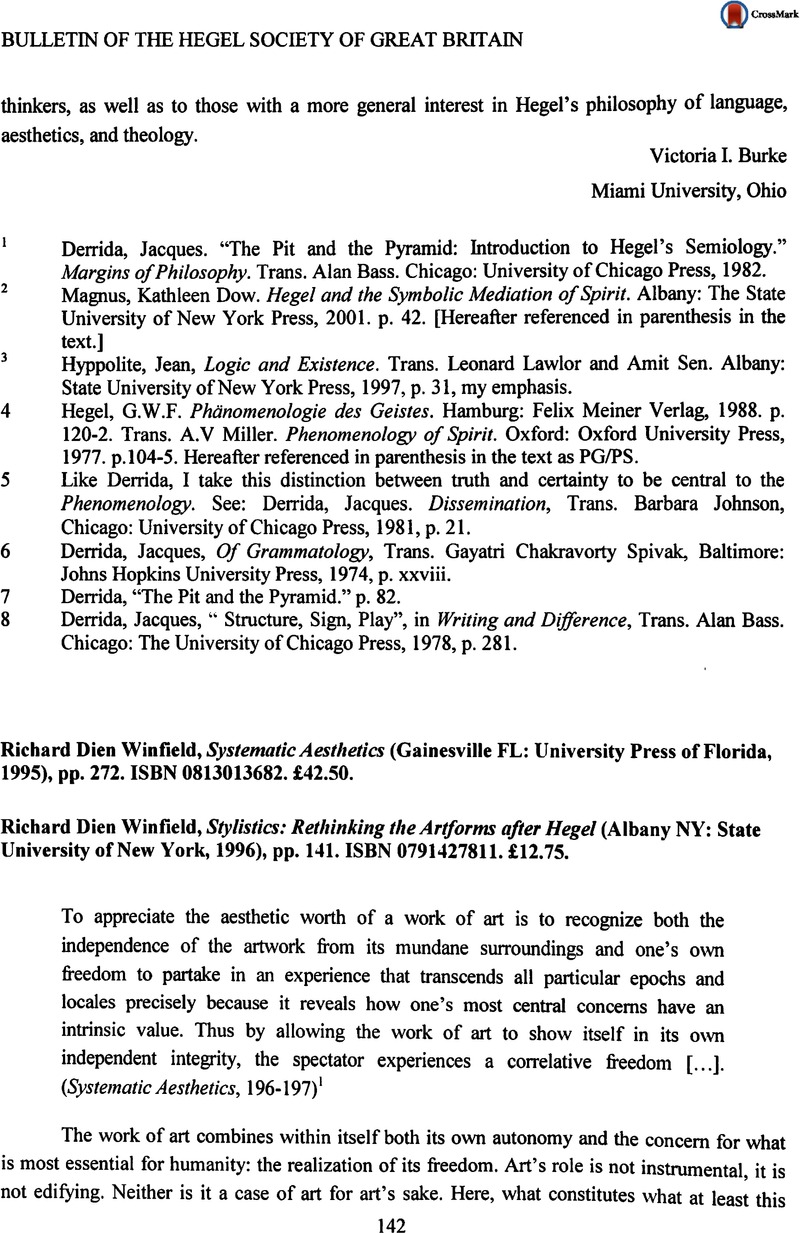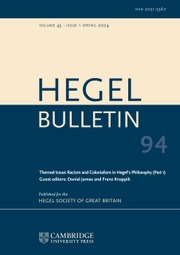No CrossRef data available.
Article contents
Richard Dien Winfield, Systematic Aesthetics (Gainesville FL: University Press of Florida, 1995), pp. 272. ISBN 0813013682. £42.50. - Richard Dien Winfield, Stylistics: Rethinking the Artforms after Hegel (Albany NY: State University of New York, 1996), pp. 141. ISBN 0791427811. £12.75.
Review products
Published online by Cambridge University Press: 23 June 2015
Abstract

- Type
- Reviews
- Information
- Bulletin of the Hegel Society of Great Britain , Volume 23 , Issue 1-2: number 45/46 , January 2002 , pp. 142 - 149
- Copyright
- Copyright © The Hegel Society of Great Britain 2002
References
1 Page references to Systematic Aesthetics will be given in the text accompanied by Aesthetics. Page references to Stylistics: Rethinking the Artforms after Hegel will be given in the text accompanied by Stylistics.
2 This argument of Winfield's draws on Foster's Michael B. Political Philosophies of Plato and Hegel (Oxford: Oxford University Press, 1968)Google Scholar.
3 Winfield's treatment of Plato provides a very good aide for the study of the relevant passages of the Republic.
4 “The failure of the metaphysical paradigm of the edifying imitative artifact to capture salient features of aesthetic phenomena recedes in significance, for what motivates the transcendental turn is not so much the content of the categories employed to conceive art, but whether they are immediately ‘discovered’ or mediately ‘constructed’ in terms of the structure of aesthetic reception” (Aesthetics, 35).
5 This inability to conceive individuality will undermine a metaphysical or transcendental treatment of any philosophical topic. However, in aesthetics, the individuality of the work of art exposes this deficiency directly.
6 The latter constitutes Hegel's heroic age.
7 It might seem that only literature can do justice to such a notion of artistic beauty. Yet, this does not follow, for “character can be disclosed in the feeling expressed by lyric poetry or music, and […] the stature of action can be reflected by the environments in which architecture houses it and landscape and still life surrounds it” (Aesthetics, 133).
8 When conduct is the topic of symbolic art, “the character of the protagonists will either be absorbed by the powers that operate through them, possess exaggerated abilities and passions that point beyond the limits of rational agency, or alternately expend itself in a self-annulling odyssey where release from the strivings of conduct becomes the individual's own culmination” (italics added) (Stylistics, 37).
9 “Classicism gives artistic expression to a self-understanding in which what individuals consider essential is fully achievable within the way of the world, where to paraphrase Lukacs, outer deeds can satisfy the soul's demands for greatness, since life is fundamentally homogeneous with intrinsic value, allowing human striving to realize essential aims already at home in the closed and complete totality of public existence” (Stylistics, 64).
10 One well-known way of taking this particular form of art into a work of art is through the device of “the quixotic plight of anachronistic figures who affirm their inner subjectivity as if the world could still allow of chivalry” (Stylistics, 85).


